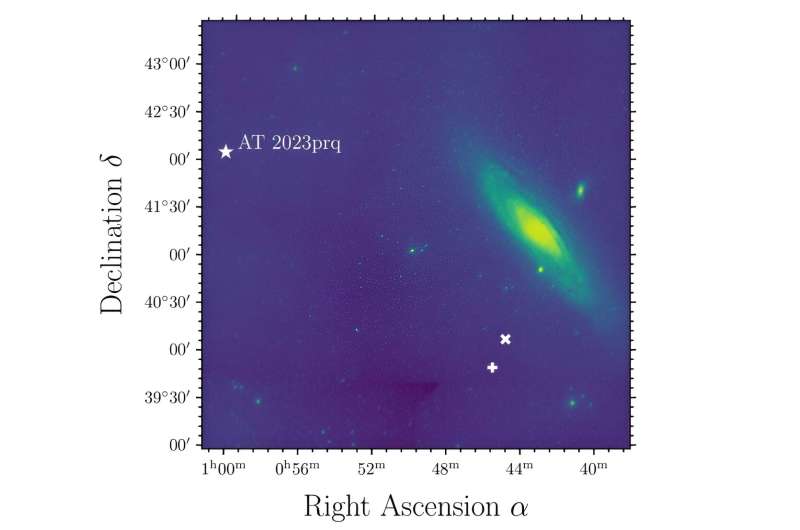November 22, 2023 report
This article has been reviewed according to Science X's editorial process and policies. Editors have highlighted the following attributes while ensuring the content's credibility:
fact-checked
trusted source
proofread
Recently discovered nova investigated by astronomers

Astronomers from the Liverpool John Moores University have performed photometric and spectroscopic observations of a recently discovered nova, known as AT 2023prq. Results of the observational campaign, published in the November issue of the Research Notes of the American Astronomical Society (AAS), shed more light on the nature of this nova.
A nova is a star experiencing a sudden increase in brightness and slowly returning to its original state, a process that could last many months. Such an outburst, which releases an immense amount of energy, is the result of the accretion process in a close binary system containing a white dwarf and its companion. Studying novae is crucial in advancing our knowledge about fundamental astrophysical processes, including stellar evolution.
AT 2023prq (other designation ZTF23aaxzvrr) was detected by the Zwicky Transient Facility (ZTF) on August 15, 2023, in the halo of the Andromeda galaxy (or Messier 31, M31). It had an r′-band magnitude of 17.13 and shortly after its detection, follow-up observations of this nova commenced in order to get more insights into its properties.
Astronomers Michael Healy-Kalesh and Daniel Perley from the Liverpool John Moores University in Liverpool, UK, were among the first to observe AT 2023prq after it was identified. They used the Liverpool Telescope (LT) and various other ground-based facilities to monitor the nova until the end of August 2023.
The observations conducted by Healy-Kalesh and Perley found that AT 2023prq had an absolute peak magnitude of about -7.6. Based on the collected data, the projected distance of this nova to the Andromeda galaxy was measured to be approximately 150,000 light years.
According to the study, AT 2023prq has a very short decline time—about 3.4 days. This, together with its low absolute magnitude, suggests that this object may belong to the "faint-and-fast" category of novae.
Furthermore, spectroscopic observations of AT 2023prq detected helium emission lines in the spectra of this nova, and relatively high ejecta velocities from the hydrogen-alpha emission line. These findings indicate that AT 2023prq, unlike other spectroscopically classified halo novae, belongs to the helium/nitrogen spectroscopic class.
Summing up the results, the authors of the paper concluded that AT 2023prq is a classical nova. In classical novae, the hydrogen-rich matter accreted from the donor eventually reaches a critical pressure and undergoes a thermonuclear runaway at the accreted layer's base. During an eruption, these novae can reach absolute magnitudes up to -10.5.
The researchers noted that AT 2023prq is "hostless"—therefore located at a relatively large distance from the Andromeda galaxy. According to them, the observations confirm that AT 2023prq belongs to the halo of this galaxy and is one of the most distant novae from its host so far detected.
More information: Michael W. Healy-Kalesh et al, AT 2023prq: A Classical Nova in the Halo of the Andromeda Galaxy, Research Notes of the AAS (2023). DOI: 10.3847/2515-5172/ad0a99
© 2023 Science X Network





















